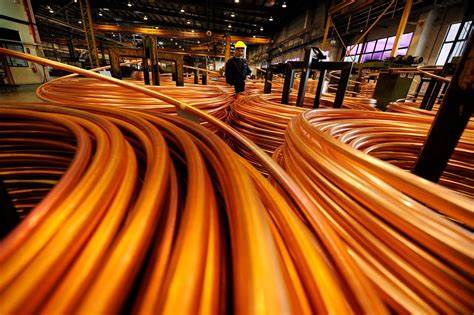The recent developments in the copper market, particularly the surge in stockpiles in China and the subsequent weakening of demand, have introduced significant challenges and uncertainties, particularly amid a recent rally in copper prices. Historically, Chinese copper inventories tend to peak in March and then decline as factories gear up production for the summer months. However, this year has seen an unexpected deviation from this trend, with stockpiles held in Shanghai Futures Exchange warehouses reaching record highs, surpassing 300,000 tons by the end of May.
This unexpected rise in inventories comes at a time of turbulence for the Chinese economy, characterized by mixed manufacturing data. While the official factory gauge for May indicated a contraction, a private survey focusing on smaller, export-oriented firms showed some modest improvement. Despite this, the optimism in the global copper sentiment, which led prices to peak at $11,100 per ton in May, has been overshadowed by the realities of weak demand in China, resulting in prices slipping below the $10,000 per ton mark.
Adding to the pressure on copper prices are the record stockpiles at the London Metal Exchange (LME), which reflect an abundance of supply in the market. Carsten Menke, head of Next Generation Research at Julius Baer, noted that the copper market appears to be adequately supplied, contrary to the expectations of some traders. Consequently, the likelihood of a rapid turnaround in copper prices seems remote, with the market expected to undergo a period of consolidation during the summer months.
The weakening Chinese demand is further underscored by the decline in the Yangshan premium, which has slipped into negative territory since the previous month. Traditionally, buyers of imported copper would pay a premium over the international price, but this reversal indicates a shift in dynamics, with Chinese buyers now seeking discounts.
Meanwhile, signs of a slowdown in the U.S. economy, such as the decline in job openings according to the latest Job Openings and Labor Turnover Survey (JOLTS), have reinforced expectations of potential interest rate cuts by the Federal Reserve. These expectations have further influenced copper prices, adding another layer of uncertainty to the market.
Despite these developments, there are diverging opinions among institutions regarding the future trajectory of copper prices. While investment bank Liberum anticipates a significant price drop in the event of Federal Reserve interest rate cuts, with forecasts ranging from $7,000 to $7,500 per ton, Goldman Sachs holds a more bullish outlook, predicting copper prices to reach $12,000 per ton by the end of the year.
In summary, the surge in copper stockpiles in China and weakening demand have introduced downward pressure on prices, with uncertainties regarding the future direction of the market influenced by factors such as U.S. economic trends and potential Federal Reserve actions. These dynamics underscore the complexities and volatility inherent in the copper market, requiring stakeholders to closely monitor developments and adapt strategies accordingly.
